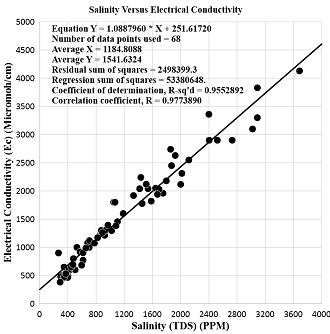Vol 6 No 1 (2024)
Research Article
Groundwater is often considered the main source of freshwater in many places worldwide. Due to their importance and susceptibility to depletion and contamination, efficient management of groundwater resources is needed. Groundwater quality depends on many factors, including geology, source water quality, and land use type. The present study dealt with the hydrochemistry of groundwater resources in the Khanaqin district, which is located in Diyala Governorate in the northeast of Iraq. The exposed geological formations in Khanaqin district range in age from Upper Jurassic up to Recent. Quaternary deposits, Bai Hassan and Injana formations were the two main types of groundwater aquifers, unconfined and confined. 68 well samples were used in hydrochemical analysis. The groundwater sampling included both aquifers in the area. The physicochemical parameters showed that the groundwater of aquifers is moderately brackish to saline. A strong linear relationship between the salinity (TDS) and electrical conductivity (EC) was obtained in the studied area. The correlation coefficient (R) was 97.73%. The salinity distribution showed a large area in the northeastern and southwestern parts of the studied area where the salinity decreased below 1000 PPM. The central and eastern parts of the studied area showed a significant increase in salinity concentration. Two polluted locations were located in the area of study with salinity concentration over 2000 PPM. The origin of groundwater was continental with a moderate brackish to saline type. 53% of the two major types of groundwater were determined in the studied area, calcium sulphate and calcium bicarbonate, with 18 samples for each one. The utilization of groundwater in the area indicates that thirty-six samples of groundwater could be used for human purposes, while fifty-eight and sixty-eight samples were utilized to be used for agriculture and animal purposes, respectively.
Groundwater is an essential natural water resource that supplies the population for various domestic, agricultural, and industrial uses. Mandali Basin, located in Diyala Governorate, in the eastern side of Iraq, was investigated during the fieldwork in 2024. The results showed that the unconfined aquifer consists of interbedded of Bai Hassan formation and Quaternary deposits. The average thickness of this aquifer was 46 meters, while the average water permeability (transmissivity) was 112 square meters/day, with 655 cubic meters/day of maximum yields. The direction of groundwater movement begins from the north-eastern part towards the south-western part in the studied area. The distribution map of salinity of groundwater demonstrates increasing values on the western side of the area. The physical and chemical parameters indicate a continental origin of the groundwater, as it is brackish to saline water. The calcium sulfate was the dominant groundwater type. The groundwater is mainly useful for livestock and irrigation purposes, while some samples indicate its use for human benefits. The area between Mandali and Qazaniya towns reflects a qualified location to increase well drilling, where the aquifer thickness, transmissivity, and maximum yields increase, while salinity decreases.
Hierarchical System of Landscape-geographial Spaces and Mechanisms of its Formation
A strategy for quantitative analysis of mono- and polysystemic organization of multi-level geospaces is described, with the construction of a series of empirical models of inter-component and inter-complex connections. The “micro-” and “macrosubstrate” approaches to the structural and functional analysis of the state of the natural environment are combined. As a methodological basis, a provision on the structural levels of natural-territorial organization is proposed, based on the conceptual cybernetic model of the natural complex as a hierarchical control system. A cybernetic model of the natural complex has been created as a hierarchical control system; the model has enriched modern ideas about the mechanisms and structural levels of the spatial organization of the natural environment. Model has enriched modern ideas about the mechanisms and structural levels of the spatial organization of the natural environment. An experiment was performed in order to analysis the state of geographical spaces by three blocks of cybernetic model: landscape frame, processor, and landscape pattern. Based on this model, a system of conjugation of different-level characteristics of natural components with the taxonomic rank of geographic spaces (from the geographical sector and natural zone to landscape facies and biogeocoenosis) was constructed. Using the Volga River basin as an example, a comparative assessment of environmental factors in their landscape-forming influence was carried out.
Hydrogeological and hydrochemical study of groundwater aquifer in Wasit Governorate, Eastern Iraq
The main aim of groundwater studies is to assess the physical and chemical characterizations of water-bearing layers as a goal for assessing their suitability for various purposes Wasit Governorate, which is located in eastern Iraq, is an important area in terms of agriculture and poultry and livestock husbandry. The area mainly depends on groundwater, especially on the Iraqi-Iranian border. The area was investigated (40) wells inventoried during the field study and used to demonstrate the hydrogeological and hydrochemical properties. The groundwater aquifer is composed of Quaternary deposits and Mukdadiyah formation. The mean thickness, transmissivity, and maximum yields were 53 meters, 114 m2/day, and 600 m3/day, respectively. The groundwater moved partially to the western parts and mainly towards the southern parts of the area towards Shuwaicha Marsh, which is located outside the study area. The salinity map showed a regular decrease in salinity concentrations towards the central and southwestern parts of the area due to groundwater recharge from infiltrated surface water. The groundwater is brackish to saline, with two dominant calcium and sodium sulphate types. The central area between Zurbatia and Badra towns can be a qualified location to increase well drilling due to salinity decreasing as the transmissivity and maximum yields increase.



 Hussein Ilaibi Zamil Al-Sudani
Hussein Ilaibi Zamil Al-Sudani



